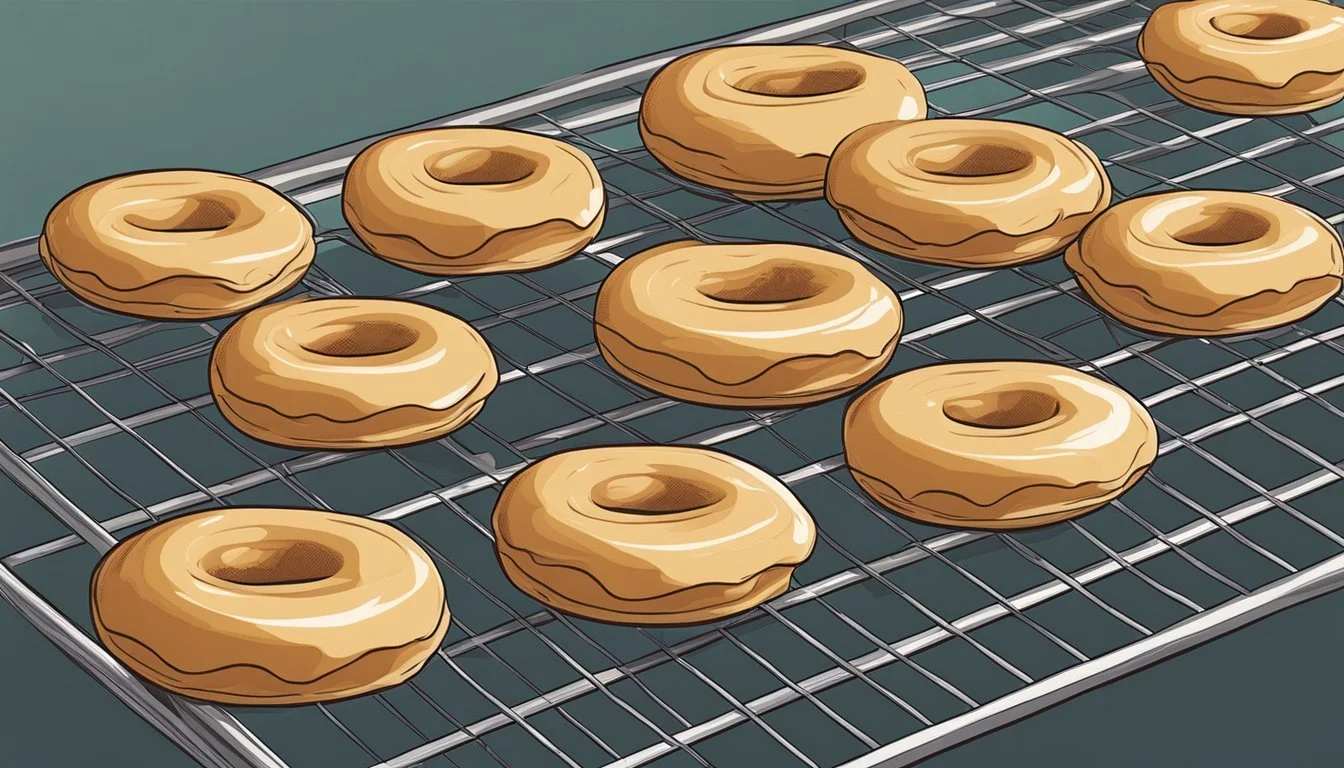Reviving Stale Donuts
Simple Steps to Restore Your Pastries to Perfection
Donuts are a beloved treat enjoyed by many as a breakfast option, dessert, or a quick snack. Their soft, fluffy texture and sweet glaze or powdered sugar coating make them an irresistible indulgence. However, donuts are best enjoyed fresh, and often they lose their appeal once they become stale. The challenge of restoring a stale donut to its former glory is one that many have faced, with varying degrees of success.
Fortunately, there are effective techniques to breathe new life into day-old donuts, making them almost as good as the moment they were fried. Reviving stale donuts is a matter of applying gentle heat to restore moisture and softness without overcooking or burning the delicate pastry. This transformation ensures that the enjoyment of a donut is not limited to its first day of freshness, thereby reducing waste and allowing for the savoring of a beloved treat beyond its perceived shelf life.
Understanding Donut Staleness
Donuts lose their appealing texture and taste over time, a process known as staleness. This deterioration affects both the freshness and enjoyment of the pastry.
Causes of Staleness
The leading cause of donut staleness is the loss of moisture, which is inevitable once the donuts are exposed to air. Donuts are prone to drying out, and their sugary coatings can absorb moisture from the air, causing them to become sticky or soggy. Other factors include:
Environmental exposure: Donuts left uncovered absorb surrounding smells and air, accelerating staleness.
Time: The freshness of a donut decreases as time passes from the moment of baking or purchase.
The Science of Retrogradation
Staleness in donuts is not just about drying out; it involves a process called retrogradation, which affects the starch molecules within the pastry. Upon baking, the starches gelatinize and absorb water, making the donut soft and fluffy. However, as the donut cools:
Starch molecules realign: They slowly crystallize, causing the donut to harden.
Moisture is expelled: The crystallizing process leads to moisture loss, leaving the donut stale and tough.
Donuts exhibit this process more rapidly than many other baked goods, largely due to their high sugar and fat content, which affects the moisture retention within the starch structure.
Stale Donut Revival Techniques
Reviving stale donuts effectively restores their softness and warmth, making them enjoyable once again. The techniques vary depending on the tools available and the desired level of moistness and heat.
Using the Oven or Toaster Oven
Oven Reheating:
Preheat the oven to 350°F (180°C).
Place the donuts on a baking tray lined with parchment paper.
For extra moisture, lightly sprinkle water on the donuts and cover them with aluminum foil.
Heat the donuts for 5 minutes. Check if they are warm—if not, continue heating for 1-2 additional minutes.
Toaster Oven Method:
Preheat the toaster oven as you would a conventional oven.
Place the donuts on the tray and heat for 3-4 minutes, checking for the desired warmth.
The Microwave Method
Microwave Heating:
Wrap the donut in a damp paper towel to prevent it from drying out.
Microwave on high for 15 seconds. Check its warmth and softness; if necessary, continue heating in 5-second intervals.
Stovetop Reheating Options
In a Frying Pan:
Warm a frying pan over medium heat.
Place the donut in the pan for 30 seconds, then flip it over for another 30 seconds.
The donut will regain some crispness on the outside while the inside stays soft.
Alternative Uses for Stale Donuts
As donuts age, their texture changes, making them less ideal for direct consumption; however, they can be repurposed into delightful dishes. Utilizing stale donuts not only reduces food waste but also transforms them into something savory or sweet for a new culinary experience.
Donut Bread Pudding Creation
Bread pudding, a comforting dessert traditionally made from stale bread, can be elevated by substituting bread with leftover donuts. Donut bread pudding infuses rich flavors into the classic dish. The key steps involve:
Cube the stale donuts into small pieces.
Soak the pieces in a custard mixture made from eggs, milk, sugar, and vanilla extract.
Place the soaked donut pieces into a baking dish and cook at 350°F (175°C) until the custard is set and the top is golden.
Crafting Donut French Toast
Transforming stale donuts into donut french toast is a clever way to give them new life. This twist on traditional French toast is simple:
Whisk together eggs, milk, and a pinch of sugar to create the egg wash.
Slice the donuts in half horizontally to allow for better soaking.
Submerge each half in the egg mixture, then cook on a buttered skillet until each side is golden and crisp.
Transforming Donuts into Croutons
For a unique twist on salad toppings or soup garnishes, stale donuts can be made into sweet and crunchy croutons.
Cut the donuts into small, bite-sized cubes.
Drizzle with a bit of melted butter and a sprinkle of cinnamon sugar, if desired.
Bake in an oven preheated to 300°F (149°C) until they are crisp, usually about 10 minutes.
By converting stale donuts into bread pudding, French toast, or croutons, their utility extends beyond the breakfast table, breathing new life into what could have been wasted.
Preservation Strategies for Donuts
Proper storage techniques can significantly extend the freshness and flavor of donuts, whether for short-term enjoyment or longer-term consumption.
Short-Term Storage Solutions
For individuals aiming to savor their donuts within a day or two, maintaining the soft and fluffy texture of the pastries is key. It is advisable to store donuts at room temperature in an airtight container. This minimizes exposure to air and humidity, which can accelerate staling. For those with cream-filled or glazed donuts, placing them in the fridge can help preserve their quality. However, one should ensure to tightly wrap the donuts in plastic wrap or aluminum foil to prevent them from absorbing other odors from the fridge.
Room Temperature: Store in an airtight container away from direct sunlight.
Refrigeration: Wrap tightly; ideal for cream-filled or highly perishable donuts.
Long-Term Freezing Technique
Donuts can be frozen for long-term storage, answering the common question, "Can I freeze donuts?" Yes, they can be frozen, with care taken to wrap individual donuts in plastic wrap or aluminum foil, then placing them in a freezer-safe bag to prevent freezer burn and absorb odors. When one is ready to enjoy a previously frozen donut, they should thaw it at room temperature before gently reheating to restore its freshness.
Wrap each donut individually.
Place in a freezer-safe bag.
Label with the date to track freshness.
Thaw at room temperature before consuming.
Enhancing Flavors and Textures
A stale donut doesn't mean the loss of an indulgent treat; with the right toppings and pairings, one can revitalize both its appeal and palate. This revitalization focuses on complementing the donut's inherent flavors and improving texture for a more enjoyable experience.
Selecting the Right Toppings
Glazes: The moist sheen of a glaze can restore the original appeal of a donut. For chocolate donuts, a chocolate glaze can deepen the cocoa flavors, whereas a simple sugar glaze boosts a plain donut.
Crunch Factor: Adding toppings like nuts or sprinkles introduces a contrasting texture to the softness of the revived donut.
Sugar Tactics:
Powdered Sugar: A light dusting gives a gently sweet lift.
Sugar Syrup: For extra moistness, a thin sugar syrup soak can rehydrate the donut without making it soggy.
Butter: Brushing with melted salted butter before reheating can enrich flavor and add a soft, luxurious texture.
Pairing with Drinks and Dishes
Coffee: For glazed and sugary donuts, coffee is an ideal companion. The bitterness of a strong cup of coffee balances the sweetness, and the flavors of both are enhanced.
Chocolate Pairings:
Dark Chocolate: Best with fruity donuts
Milk Chocolate: Complements caramel or nutty donuts
Toppings Table:
Donut Type Suggested Topping Texture Benefit Plain Sugar Glaze Adds moistness Chocolate Chocolate Glaze, Nuts Enhances richness; adds crunch Fruit-Filled Powdered Sugar, Fruit Sauce Highlights natural fruit flavors; adds smoothness
Textural Enhancements:
Stale Donut Tip: Reheat gently to maintain a balanced texture. Microwaving for 10-15 seconds or reheating in an air fryer can bring back the donut's soft, fluffy qualities without overcooking.
Specialty Donut Considerations
When reviving stale donuts, one must take into account the type of donut to ensure it retains its texture and flavor. Special considerations are needed for donuts that come with fillings or unique icing as well as for those with distinctive shapes and sizes.
Handling Filled and Frosted Varieties
Filled donuts, such as those packed with cream or jelly, require gentle warming to avoid turning the filling into a liquid mess. It is suggested to heat them at low temperature in a microwave for a short burst of time, typically 10-15 seconds. Here, one avoids the filling from seeping out or becoming overly runny.
Frosted donuts or those with a glazed donut topping, should not be heated in an oven, as high heat can melt the frosting and alter the intended flavor composition. Placing them under a microwave-safe cover and microwaving for just under 10 seconds can warm them without causing the frosting to melt away.
Accommodating Unique Shapes and Sizes
Donuts such as the maple bar can be challenging to warm evenly due to their elongated shape. One should position them on their sides and rotate halfway through warming to avoid uneven heating.
Donuts with a rich, brioche-like flavor and texture often benefit from a gentle refresh in a toaster oven set to a low temperature to enhance their buttery taste without drying them out. It is crucial to monitor them closely to ensure they do not overheat, as this can compromise their delicate brioche quality.
Reheating Donut Best Practices
When reheating donuts, one must strike a balance between restoring freshness and preventing drying out or sogginess. Accurate times and temperatures are crucial for different types of donuts, such as glazed donuts or Krispy Kreme.
Common Mistakes to Avoid
Placing donuts in an oven that hasn't preheated can lead to uneven heating and can greatly impact the texture.
Overheating is a prevalent error, especially when using a microwave, which can turn a donut tough rather than soft.
Neglecting moisture: When reheating glazed donuts, a lack of moisture can make the glaze melt unevenly and can dry out the pastry.
Using excessively high temperatures can cause the sugars in the glaze to burn, spoiling the flavor of the donut.
Optimal Reheating Times and Temperatures
Method Time Temperature Microwave 10-15 secs High power Oven 5-10 mins 350°F (177°C) Skillet N/A Medium heat Air Fryer Not advised* N/A Steamer N/A Enough to create steam
For glazed donuts, a short time in the microwave (10-15 seconds on high power) is often sufficient. Cover with a damp paper towel to add moisture.
Krispy Kreme donuts specifically benefit from 8 seconds in the microwave per donut, as recommended by the company to restore that 'just baked' quality.
In an oven, preheat to 350°F (177°C) and heat the donuts on a baking sheet for about 5 minutes. If the donuts aren't sufficiently warm, continue heating in one-minute increments.
Reheating in a skillet over medium heat can give a slight crunch to the exterior, but one must carefully monitor to avoid burning the sugars in the glaze.
*Air fryers do not provide the moisture needed for stale donuts and can make them drier, so this method is not advised for most varieties.
Donut-Related FAQ
The following frequently asked questions address common concerns regarding the storage, shelf-life, and revival techniques for donuts, ensuring they remain a delightful treat.
Can I Refreeze Thawed Donuts?
It is possible to refreeze donuts that have been thawed, but this should be done cautiously. Refreezing can affect the texture and taste, with a risk of increased dryness in the donut. If one must refreeze, ensuring the donuts are tightly wrapped or sealed can help preserve their moisture to some extent.
Are Donuts Still Good After a Week?
Donuts are typically best enjoyed within 1 to 2 days when kept at room temperature. After a week, they are likely to become stale. Refrigerated donuts may last slightly longer, but for optimal freshness and taste, consumption within a few days is recommended.
How to Tell if a Donut Has Gone Bad?
One can usually tell if a donut has spoiled by:
Visual inspection: Mold or unusual spots are clear indicators of spoilage.
Smell: A sour or off odor is a strong indication that a donut has gone bad.
Texture: If the donut feels excessively hard or has become very dry, it is likely stale and not enjoyable.
Reheating tips: When reviving a donut, using an oven preheated to 350°F for about 5 minutes can help restore its softness. Microwaving for 10-15 seconds is an alternative, though it's less effective in achieving a fluffy texture.







